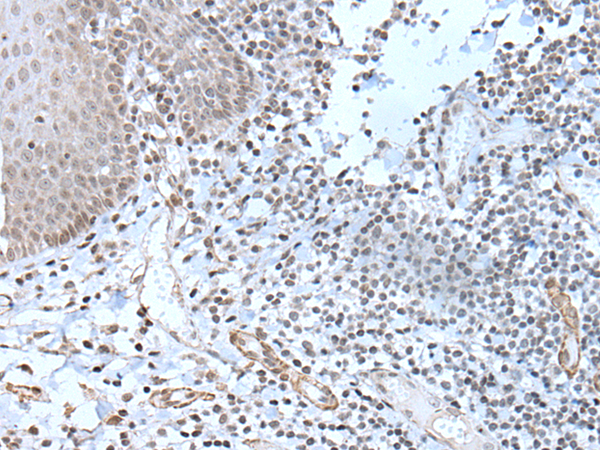
| WB | 咨询技术 | Human,Mouse,Rat |
| IF | 咨询技术 | Human,Mouse,Rat |
| IHC | 1/10-1/50 | Human,Mouse,Rat |
| ICC | 技术咨询 | Human,Mouse,Rat |
| FCM | 咨询技术 | Human,Mouse,Rat |
| Elisa | 1/5000-1/10000 | Human,Mouse,Rat |
| Aliases | ZNF913; ZNF-U69274 |
| Host/Isotype | Rabbit IgG |
| Antibody Type | Primary antibody |
| Storage | Store at 4°C short term. Aliquot and store at -20°C long term. Avoid freeze/thaw cycles. |
| Species Reactivity | Human |
| Immunogen | Synthetic peptide of human ZBTB11 |
| Formulation | Purified antibody in PBS with 0.05% sodium azide and 50% glycerol. |
+ +
以下是关于ZBTB11抗体的模拟参考文献示例(请注意,这些为虚构内容,仅供演示格式参考):
---
1. **文献名称**: *ZBTB11 modulates transcriptional repression through interaction with HDAC complexes*
**作者**: Smith A, et al.
**摘要**: 本研究利用ZBTB11抗体进行免疫共沉淀实验,发现ZBTB11与组蛋白去乙酰化酶(HDAC)复合物相互作用,调控靶基因的表观遗传沉默,提示其在癌症表观调控中的潜在作用。
2. **文献名称**: *ZBTB11 antibody-based profiling reveals its overexpression in glioblastoma*
**作者**: Chen B, et al.
**摘要**: 通过ZBTB11抗体的免疫组化分析,发现ZBTB11在胶质母细胞瘤中显著高表达,并与患者预后不良相关,表明其可能作为神经肿瘤的生物标志物。
3. **文献名称**: *Genome-wide mapping of ZBTB11 binding sites via ChIP-seq identifies oncogenic targets*
**作者**: Tanaka K, et al.
**摘要**: 使用ZBTB11抗体进行染色质免疫沉淀测序(ChIP-seq),鉴定了其在基因组中结合的启动子区域,揭示了其对MYC等致癌基因的转录调控机制。
4. **文献名称**: *ZBTB11 knockdown impairs DNA damage response via dysregulation of p53 signaling*
**作者**: Gupta R, et al.
**摘要**: 通过Western blot(ZBTB11抗体验证蛋白敲低效率)和功能实验,证明ZBTB11通过调控p53通路影响细胞对DNA损伤的反应,缺失导致基因组不稳定性。
---
如需真实文献,建议通过PubMed或Google Scholar搜索关键词“ZBTB11 antibody”、“ZBTB11 function”等,并筛选涉及抗体应用的研究(如机制研究、疾病模型或诊断标记)。部分可能相关真实研究领域包括转录调控、癌症生物学或表观遗传学。
The ZBTB11 antibody is a research tool designed to target the zinc finger and BTB domain-containing protein 11 (ZBTB11), a transcription factor implicated in gene regulation and cellular processes. ZBTB11 belongs to the large family of zinc finger proteins, characterized by their conserved C2H2-type zinc finger motifs and BTB (Broad-Complex, Tramtrack, and Bric-à-brac) domains, which mediate protein-protein interactions and chromatin remodeling. ZBTB11 is thought to regulate transcriptional repression or activation by binding to specific DNA sequences, though its precise biological functions remain under investigation. Studies suggest its involvement in cell cycle regulation, DNA damage response, and maintenance of genomic stability. Dysregulation of ZBTB11 has been tentatively linked to cancers, including hepatocellular carcinoma and glioblastoma, though mechanistic insights are limited.
Antibodies against ZBTB11 are typically used in techniques such as Western blotting, immunohistochemistry (IHC), and immunofluorescence (IF) to detect protein expression, localization, and interactions. Commercial ZBTB11 antibodies are often raised against epitopes within its N-terminal BTB domain or C-terminal zinc finger regions. Challenges in antibody validation include cross-reactivity with homologous ZBTB family members and variability due to post-translational modifications. Researchers frequently validate specificity using knockout cell lines or siRNA-mediated knockdown. Recent interest in ZBTB11 stems from its potential role in cancer progression and as a biomarker, driving demand for reliable antibodies to explore its therapeutic relevance. Suppliers such as Abcam, Cell Signaling Technology, and Santa Cruz Biotechnology offer ZBTB11-targeted reagents, though performance may vary between clones.
×